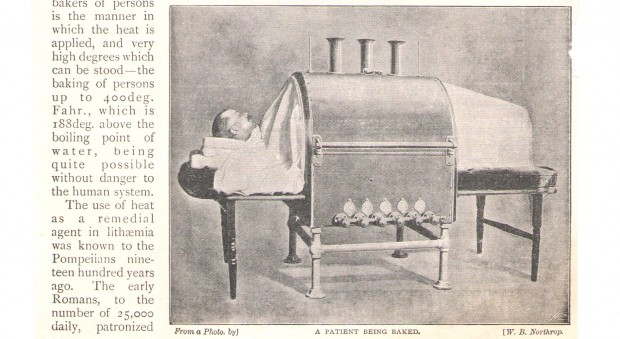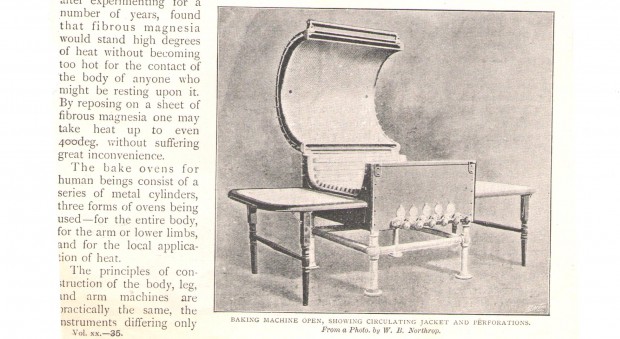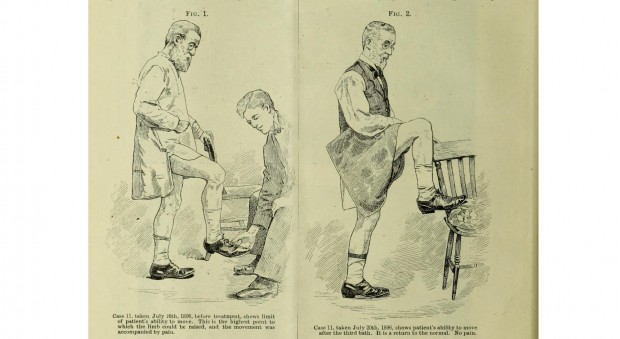While looking through a box of pamphlets in the RCP library recently, we spotted a rather remarkable title – ‘The Baking Cure’ – accompanied by a no-less surprising picture.
At first glance, the contraption looks rather like an iron lung but, reading the text, it turns out to be something rather less well-known: a medical hot-air oven designed to bake patients back to health:
Baking alive is the latest thing in American medical science. Three large human bakers are in operation in the United States – in Chicago, Philadelphia and New York respectively – and the popularity of the new treatment is growing daily.

The article's author, WB Northrop, observes that the usefulness of heat in alleviating pain has been known for centuries. Northrop cites examples such as the application of mustard plasters and the ancient Roman practice of visiting a hot-air chamber (caldarium), as part of a trip to the baths. The modern baking treatment was intended for use in cases of gout, rheumatism, inflammation and ‘all forms of pain’.
Northrop attributes the invention of the baking apparatus to Mr Sprague, of Rochester, New York. The patient would lie inside a large metal cylinder, heated using Bunsen burners, with wooden extensions at either end for the head and feet, and cork ribs inside the contraption to ‘prevent the patient’s body or hands from coming in contact with the hot cylinder, which would burn the flesh’. The article vividly describes the patient’s experiences as the temperature mounts:
When the heat is first turned on the patient experiences no sensations other than mild warmth. … Up to about 150deg. Fahr. [66°C] little inconvenience is felt. Then the patient becomes thirsty. … When 180deg. [82°C] have been registered … the patient feels thousands of tiny streams of heat impinging against his body … the lower extremities now become somewhat numb … At 200deg. [93°C] one experiences a dreamy sensation, and from this point up to 280deg. [138°C] the baking experience is really quite pleasant.

This temperature was the average used in these sorts of machines, but sometimes temperatures of 350–400°F (177–204°C) were said to be employed, with bags of ice applied to the patient’s head. Northrop describes how this treatment causes the patient to feel that they are being roasted alive, with the blood ‘coursing through the veins at racehorse speed’ and the heart thumping wildly.
The pamphlet
The pamphlet turned out to be an extract from the popular magazine The Strand from September 1900. A very similar article appeared in Everybody’s Magazine that October. A subsequent notice in The Strand notified readers that the baking cure technique did not originate with Mr Sprague, but with Lewis A Tallerman, and that the ‘Tallerman treatment’ was available in hospitals across London and the UK.

Treatment
Reports of Tallerman’s treatment appeared in The Lancet. On 12 January 1895, JF Sarjeant reported that in a trial at the North-West London Hospital ‘there was not a single failure’ when treating cases of sprains, gout, rheumatoid arthritis, a tuberculous knee-joint, and a chronic leg ulcer. W Knowsley Sibley’s August 1896 illustrated article ‘Local hot-air treatment in rheumatism and allied affections’ prompted several readers to write to the editor either endorsing the treatment or describing earlier, pre-Tallerman versions of hot-air baths. A letter from Tallerman himself was published on 31 October, defending his invention of, not the first, but the most efficacious hot-air treatment. He threatened legal action against anyone introducing ‘other apparatus to be used as a substitute’ for his own machine. In the same year, Tallerman published his own description of the ‘Patent localized hot-air bath’ and some of the cases it had successfully treated.
Little further seems to be known about Tallerman. British local newspaper reports from the late 1890s and early 1900s mention the presence of his hospitals in locations across the country, and he died suddenly at a dinner party on the evening of Saturday 17 October 1903, aged 58.
Katie Birkwood, rare books and special collections librarian
Read our weekly library, archive and museum blog to learn more about the history of medicine, and follow @RCPmuseum on Twitter and @rcpmuseum on Instagram.
